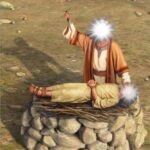1.1 The Significance of Hazrat Ibrahim (A.S.) in Islamic Tradition
Hazrat Ibrahim (A.S.), also known as Abraham in Judeo-Christian traditions, holds a central place in Islamic history. As a patriarch of monotheism, his life is a testament to unwavering faith in Allah. Among the most significant events in his life is the act of demolishing the idols worshipped by his people, an act that symbolized his absolute rejection of polytheism and his commitment to the worship of the one true God, Allah.
1.2 The Context of Idol Worship in Ancient Mesopotamia
During the time of Hazrat Ibrahim (A.S.), idol worship was widespread in his homeland, which is believed to be in Mesopotamia (modern-day Iraq). The people of his community, including his own father, were deeply entrenched in the practice of idol worship. This setting of rampant polytheism sets the stage for one of the most iconic moments in Islamic history—the destruction of the idols by Hazrat Ibrahim (A.S.).
2.1 The Context of Surah Al-Anbiya
Surah Al-Anbiya is the 21st chapter of the Quran, and it is aptly named “The Prophets,” as it recounts the stories of various prophets, including Hazrat Ibrahim (A.S.). The verses 58-70 specifically focus on the incident where Hazrat Ibrahim (A.S.) challenged the idolatrous practices of his people.
2.2 The Destruction of the Idols: Ayat 58-59
2.2.1 The Act of Demolition
“So he made them into fragments, except a large one among them, that they might return to it and question.” (Quran 21:58)
This verse describes the bold action of Hazrat Ibrahim (A.S.), who destroyed all the idols in the temple except the largest one. By leaving the largest idol intact, Ibrahim (A.S.) set the stage for his people to confront the futility of their worship.
2.2.2 The Purpose Behind the Destruction
Hazrat Ibrahim (A.S.) intended to demonstrate the helplessness of the idols and provoke his people into questioning the logic of idol worship. By sparing the largest idol, he provided an opportunity for his people to realize that these idols had no power, as they could neither defend themselves nor provide any benefit to their worshippers.
2.3 The Confrontation: Ayat 60-64
2.3.1 The Accusation
“They said, ‘Who has done this to our gods? Indeed, he is of the wrongdoers.’ They said, ‘We heard a young man mention them who is called Ibrahim.'” (Quran 21:59-60)
Upon discovering the destruction, the people of Ibrahim (A.S.) were outraged and immediately sought to find the culprit. They recalled that Ibrahim (A.S.) had spoken against the idols, and thus he was quickly accused of the act.
2.3.2 Ibrahim’s (A.S.) Defense
“He said, ‘Rather, this – the largest of them – did it, so ask them, if they should [be able to] speak.'” (Quran 21:63)
In a profound display of logic and wit, Ibrahim (A.S.) pointed to the largest idol as the one responsible for the destruction. His response was not meant to deceive, but rather to make his people realize the absurdity of their beliefs. If the idols were truly gods, they should be able to speak and defend themselves.
2.4 The People’s Realization and Rejection: Ayat 65-67
2.4.1 The Moment of Reflection
“So they returned to [blaming] themselves and said [to each other], ‘Indeed, you are the wrongdoers.'” (Quran 21:64)
For a brief moment, the people of Ibrahim (A.S.) were struck by the logic of his argument and recognized their own folly. However, this realization was fleeting as their arrogance and attachment to their ancestral traditions quickly overshadowed this moment of clarity.
2.4.2 The Return to Stubbornness
“Then they reversed themselves, [saying], ‘You have already known that these do not speak!'” (Quran 21:65)
Despite recognizing the truth, the people reverted to their old ways, acknowledging that the idols could not speak yet stubbornly refusing to abandon their worship. This incident highlights the deep-seated nature of their idolatry and their resistance to change, even in the face of clear evidence.
2.5 The Punishment of Ibrahim (A.S.): Ayat 68-70
2.5.1 The Decision to Punish Ibrahim (A.S.)
“They said, ‘Burn him and support your gods – if you are to act.'” (Quran 21:68)
Enraged by Ibrahim’s (A.S.) actions and the challenge he posed to their beliefs, the people decided to punish him by burning him alive. This was intended as a public spectacle to reaffirm their commitment to their gods and to deter others from following Ibrahim’s (A.S.) example.
2.5.2 Allah’s Divine Intervention
“Allah said, ‘O fire, be coolness and safety upon Abraham.'” (Quran 21:69)
In this critical moment, Allah intervened and commanded the fire to be cool and safe for Ibrahim (A.S.). This miraculous event not only saved Ibrahim (A.S.) but also served as a powerful sign of Allah’s support for those who stand firm in their faith.
2.5.3 The Aftermath
“And they intended for him harm, but We made them the greatest losers.” (Quran 21:70)
The people’s plan to harm Ibrahim (A.S.) backfired. Instead of destroying him, they were humiliated and became the greatest losers in both this world and the Hereafter. This incident stands as a testimony to the power of unwavering faith in Allah and the futility of opposing His will.
3.1 The Universal Message of Monotheism
3.1.1 Monotheism as the Core Message of All Prophets
The message of monotheism (Tawhid) is the central theme of all prophetic teachings. Like other prophets, Hazrat Ibrahim (A.S.) called his people to abandon the worship of false gods and to worship only Allah, the one true God. The Quran repeatedly emphasizes the importance of this message and the consequences of rejecting it.
3.1.2 The Continuation of Ibrahim’s (A.S.) Legacy in Islam
Islam considers itself the true continuation of the monotheistic tradition established by Ibrahim (A.S.). The destruction of the idols symbolizes the rejection of all forms of shirk (associating partners with Allah) and the establishment of pure monotheism.
3.2 The Hadith on Ibrahim’s (A.S.) Faith and Courage
3.2.1 The Prophet Muhammad (PBUH) on the Legacy of Ibrahim (A.S.)
In various Hadiths, the Prophet Muhammad (PBUH) praised the faith and courage of Ibrahim (A.S.). For instance, in Sahih Bukhari, it is narrated that the Prophet Muhammad (PBUH) said: “There is no prophet between me and him (Ibrahim).” (Sahih Bukhari)
This Hadith underscores the close spiritual connection between the Prophet Muhammad (PBUH) and Ibrahim (A.S.), highlighting the importance of Ibrahim’s (A.S.) mission in the broader context of Islamic teachings.
3.2.2 The Role of Ibrahim (A.S.) as a Role Model
Ibrahim’s (A.S.) unwavering commitment to monotheism and his readiness to challenge the idolatrous practices of his time serve as a timeless example for all Muslims. The Hadith literature, including Sahih Muslim and other collections within the Qutub-e-Sitta, frequently references Ibrahim (A.S.) as a role model for courage and faith.
3.3 The Broader Implications of Idol Worship in Today’s World
3.3.1 The Modern Forms of Idolatry
While traditional idol worship may not be as widespread today, the underlying principles that lead to such practices persist. Modern forms of idolatry can include the excessive attachment to wealth, power, or other worldly desires. The story of Hazrat Ibrahim (A.S.) serves as a reminder to reject all forms of idolatry, whether physical or metaphorical.
3.3.2 The Call to Return to Pure Monotheism
In a world filled with distractions and temptations, the call to return to pure monotheism is more relevant than ever. Muslims are reminded to evaluate their lives and ensure that nothing takes precedence over their worship and obedience to Allah.
Featured Latest Trending Video
Other Videos - Must Watch.....
4.1 The Timeless Lessons from the Destruction of the Idols
The incident of Hazrat Ibrahim’s (A.S.) destruction of the idols is not just a historical event; it is a powerful lesson in faith, courage, and the importance of monotheism. It teaches Muslims to stand firm in their beliefs, even in the face of overwhelming opposition, and to trust in Allah’s protection and guidance.
4.2 The Relevance of Ibrahim’s (A.S.) Story for Modern Muslims
In today’s world, where Muslims face various challenges and pressures, the story of Hazrat Ibrahim (A.S.) provides a source of inspiration and guidance. It reminds Muslims to remain steadfast in their faith, reject all forms of idolatry, and continuously strive to fulfill their duties to Allah.
4.3 The Call to Emulate the Courage and Faith of Ibrahim (A.S.)
Muslims are called to emulate the courage and faith of Hazrat Ibrahim (A.S.) in their own lives. By doing so, they can ensure that they remain true to the principles of Islam and earn the pleasure of Allah in this life and the Hereafter. After this Hazrat Ibrahim A.S. got several orders & instructions to be fulfilled during different phases in his life which are truly very meaningful to us. Hence, I am continuing this topic & for a clear understanding first highlighting those Incidents numerically in pointers & then I will discuss all those one by one Insha ALLAH S.W.T.
- Meeting with Bibi Hajara (A.S.) and the Birth of Hazrat Ismaeel (A.S.)
- The Trial of Leaving Bibi Hajara (A.S.) and Hazrat Ismaeel (A.S.) in the Desert of Mecca
- The Miracle of Zamzam and Survival in the Desert
- The Sacrifice of Hazrat Ismaeel (A.S.)
- Meeting with Angels and the Destruction of the People of Loot (A.S.)
- The Construction of the Kaaba
1.1 The Marriage of Hazrat Ibrahim (A.S.) to Bibi Hajara (A.S.)
Hazrat Ibrahim (A.S.) was initially married to Hazrat Sarah (A.S.), who was unable to bear children for many years. With the permission of Sarah (A.S.), Ibrahim (A.S.) married Bibi Hajara (A.S.), an Egyptian woman of noble character. Allah blessed this marriage with the birth of Hazrat Ismaeel (A.S.), who would later play a crucial role in Islamic history.
1.2 The Birth of Hazrat Ismaeel (A.S.)
The birth of Hazrat Ismaeel (A.S.) was a moment of great joy for Hazrat Ibrahim (A.S.), as it fulfilled his long-standing desire to have a son. This event is significant because Ismaeel (A.S.) would later become a prophet and the ancestor of the Arab people, including the Prophet Muhammad (PBUH).
2.1 Allah’s Command to Leave Them in the Desert
Shortly after the birth of Hazrat Ismaeel (A.S.), Allah commanded Hazrat Ibrahim (A.S.) to take Bibi Hajara (A.S.) and his newborn son to a barren, uninhabited desert. This place was later known as Mecca. The command was a test of Ibrahim’s (A.S.) faith, trust, and obedience to Allah.
2.2 The Departure and the Trust of Bibi Hajara (A.S.)
Despite the apparent harshness of the command, both Hazrat Ibrahim (A.S.) and Bibi Hajara (A.S.) displayed remarkable trust in Allah. Ibrahim (A.S.) left them with limited provisions and, as he walked away, Bibi Hajara (A.S.) asked if this was a command from Allah. Upon his affirmation, she expressed her trust that Allah would not abandon them.
2.3 The Desolate Environment of Mecca
At the time, Mecca was a lifeless desert, with no water or vegetation. The situation seemed dire, but the faith and resilience of Bibi Hajara (A.S.) ensured that she remained steadfast, awaiting Allah’s mercy and provision.
3.1 The Struggle for Water
After Hazrat Ibrahim (A.S.) left, the provisions soon ran out. Bibi Hajara (A.S.), desperate to find water for her thirsty son, ran back and forth between the hills of Safa and Marwah seven times, searching for any sign of water. This act of faith and desperation is commemorated in the ritual of Sa’i during Hajj.
3.2 The Miracle of Zamzam
At the moment when all hope seemed lost, the angel Jibreel (A.S.) appeared and struck the ground with his wing, causing a miraculous spring of water to gush forth at the feet of Hazrat Ismaeel (A.S.). This water, known as Zamzam, not only sustained Bibi Hajara (A.S.) and her son but continues to flow to this day, providing water to millions of pilgrims every year.
3.3 The Growth of Mecca
The presence of Zamzam attracted nomadic tribes to the area, leading to the establishment of the city of Mecca. Bibi Hajara (A.S.) and Hazrat Ismaeel (A.S.) were no longer alone, and Mecca soon became a thriving settlement.
4.1 The Divine Command to Sacrifice
Years after leaving Bibi Hajara (A.S.) and Hazrat Ismaeel (A.S.) in Mecca, Allah tested Hazrat Ibrahim (A.S.) with a heart-wrenching command. In a dream, Ibrahim (A.S.) was instructed to sacrifice his beloved son, Ismaeel (A.S.), as an act of obedience to Allah.
4.2 The Obedience of Hazrat Ibrahim (A.S.) and Hazrat Ismaeel (A.S.)
When Ibrahim (A.S.) informed Ismaeel (A.S.) of the dream, Ismaeel (A.S.) displayed remarkable submission, encouraging his father to fulfill Allah’s command. This mutual obedience is a profound example of faith and trust in Allah, illustrating the depth of their commitment to Him.
4.3 The Replacement with a Ram
As Ibrahim (A.S.) prepared to sacrifice his son, Allah intervened and sent a ram to be sacrificed in Ismaeel’s (A.S.) place. This event, commemorated annually during Eid al-Adha, symbolizes the willingness to submit to Allah’s will and the mercy that Allah bestows upon those who obey Him.
4.4 The Significance of the Sacrifice in Islam
The story of the sacrifice is a cornerstone of Islamic tradition, teaching the values of faith, obedience, and the ultimate mercy of Allah. It is celebrated during Eid al-Adha, where Muslims around the world perform the sacrifice of an animal in remembrance of this event.
5.1 The Visit of the Angels
Before the destruction of the people of Loot (A.S.), a group of angels visited Hazrat Ibrahim (A.S.) in the form of guests. Unaware of their true identity, Ibrahim (A.S.) prepared a meal for them, but they did not eat, which caused him concern. The angels then revealed their true identity and their mission to destroy the corrupt people of Sodom, where Loot (A.S.) was a prophet.
5.2 The Plea for the People of Loot (A.S.)
Hazrat Ibrahim (A.S.), known for his compassionate nature, pleaded with the angels to spare the people of Loot (A.S.). However, the angels informed him that the decree of Allah was final and that the punishment was inevitable due to the severe corruption and immorality of the people.
5.3 The Destruction of Sodom
The angels proceeded to the city of Sodom, where they carried out Allah’s command. The city and its inhabitants were destroyed by a severe punishment, sparing only Loot (A.S.) and his family, except for his wife, who was among those who perished due to her betrayal.
5.4 The Lessons from the Destruction of Loot (A.S.)
The destruction of the people of Loot (A.S.) serves as a stern warning against immorality and disobedience to Allah. It underscores the importance of following divine guidance and the consequences of straying from the path of righteousness.
6.1 The Command to Build the Kaaba
After the events of the sacrifice, Allah commanded Hazrat Ibrahim (A.S.) and Hazrat Ismaeel (A.S.) to construct the Kaaba, the sacred House of Allah in Mecca. This structure would become the central place of worship for all Muslims and the focal point of the Islamic practice of Hajj.
6.2 The Foundation of the Kaaba
With the guidance of Allah, Ibrahim (A.S.) and Ismaeel (A.S.) laid the foundations of the Kaaba. The Quran mentions this event in Surah Al-Baqarah, where Ibrahim (A.S.) and Ismaeel (A.S.) pray for the acceptance of their efforts and for the future generations to remain steadfast in worshipping Allah alone.
6.3 The Legacy of the Kaaba
The Kaaba is not just a physical structure; it symbolizes the unity of the Muslim Ummah and the centrality of monotheism in Islam. Muslims around the world face the Kaaba during their daily prayers, and it is the destination of millions of pilgrims who perform Hajj and Umrah each year.
6.4 The Rituals Associated with the Kaaba
The construction of the Kaaba also established the rituals associated with Hajj, including the Tawaf (circumambulation) of the Kaaba and the Sa’i between Safa and Marwah, which commemorates Bibi Hajara’s (A.S.) search for water. These rituals are a testament to the enduring legacy of Hazrat Ibrahim (A.S.) and his family in Islamic practice.
The life of Hazrat Ibrahim (A.S.) is filled with incidents that illustrate his unwavering faith, obedience, and trust in Allah. From his confrontation with idolatry to his trials with his family, every event in his life serves as a lesson for Muslims. His legacy continues to inspire and guide Muslims, as seen in the rituals of Hajj and the significance of the Kaaba in daily prayers.
***For Related Searches:-
#IbrahimIconoclast #IslamicLegacy #ZamzamMiracle #SacrificeInIslam #ProphetIbrahim #KaabaConstruction #QuranicStories #FaithAndObedience #IslamicMonotheism #MuslimHistory #QutubESitta #QuranAndHadith #IslamicTeachings #MuslimRoleModels #DivineTests #QaumLootDestruction #IslamicRituals #IbrahimIconoclast #DemolitionOfIdols #MonotheismInIslam #IslamicFaith #SurahAlAnbiya #QuranicStories #ProphetIbrahim #FaithAndCourage #IslamicMonotheism #HadithOnIbrahim #RejectingIdolatry #QutubESitta #QuranAndHadith #IslamicTeachings #MuslimRoleModels












